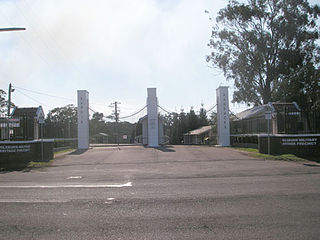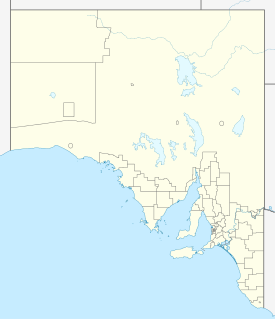 W
WThe Berrima Correctional Centre is an Australian prison, located at Berrima, New South Wales. The Centre was operational between 1839 and 2011 with a number of breaks in between, and was re-opened in September 2016. Initially established as Berrima Gaol, the facility closed in 1909 and reopened in 1949 as the Berrima Training Centre. The Centre is the oldest Australian correctional facility in operation. It was added to the New South Wales State Heritage Register on 2 April 1999.
 W
WBlackboy Hill was named after the Australian native "black boy" plants, Xanthorrhoea preissii, which dominated the site which is now absorbed into Greenmount, Western Australia.
 W
WCamp Cable, Australia was a World War II army training base near Logan Village, Queensland, Australia.
 W
WThe Cowra breakout occurred on 5 August 1944, when 1,104 Japanese prisoners of war attempted to escape from a prisoner of war camp near Cowra, in New South Wales, Australia. It was the largest prison escape of World War II, as well as one of the bloodiest. During the escape and ensuing manhunt, 4 Australian soldiers and 231 Japanese soldiers were killed. The remaining escapees were re-captured and imprisoned.
 W
WThe Hay Internment and POW camps at Hay, New South Wales, Australia were established during World War II as prisoner-of-war and internment centres, due in no small measure to the isolated location of the town. Three high-security camps were constructed in 1940. The first arrivals were over two thousand refugees from Nazi Germany and Austria, most of whom were Jewish; they had been interned in the United Kingdom when fears of an armed invasion of Britain were at their peak. The British government then made the decision to forcibly transport these refugees to Australia on the HMT Dunera. The internees were kept in conditions on board the Dunera that were cruel and inhumane, and after the war the Dunera story became quite infamous, leading the British government to apologise for their egregious mistreatment of innocent civilian refugees. The internees arrived at Hay on 7 September 1940 by four trains from Sydney. They were interned in Camps 7 and 8 under the guard of the 16th Garrison Battalion of the Australian Army. In November 1940 the other compound at Hay, Camp 6, was occupied by Italian civilian internees. Camps 7 and 8 were vacated in May 1941 when the Dunera internees left Hay; some were sent to Orange (NSW), others to Tatura in Victoria, and others to join the Pioneer Corps of the Australian Army. Upon their departure Italian prisoners-of-war were placed in Camps 7 and 8. In December 1941 Japanese internees were conveyed to Hay and placed in Camp 6. In April 1942 the River Farm began operating on the eastern edge of the township, enabling market-gardening and other farm activities to be carried out by the Italian internees and POWs. In February 1945, in the wake of the Cowra POW break-out, a large number of Japanese POWs were transferred to Hay and placed in the three high-security compounds. On 1 March 1946 the Japanese POWs departed from Hay in five trains, transferred to Tatura. During 1946 the Italians who remained at Hay were progressively released or transferred to other camps, and the Hay camps were dismantled and building materials and fittings sold off by June the following year.
 W
WIngleburn Army Camp was a purpose built camp constructed in 1940 for the Australian Army at Ingleburn, New South Wales, Australia.
 W
WKatarapko Wood Camp was a World War II prisoner of war camp, located on Katarapko Island, on the River Murray near Loxton, in South Australia's Riverland. It was officially part of the Loveday POW Camp complex, and housed Italian prisoners of war, who were employed as wood cutters for the Allied war effort. It was similar to wood camps throughout South Australia at the time, including two others attached to the Loveday POW camps - Moorook West and Woolenook.
 W
WLangwarrin is a suburb of Melbourne, Victoria, Australia, 42 km (26 mi) south-east from Melbourne's central business district. Its local government area is Frankston City. At the 2016 census, Langwarrin had a population of 22,588.
 W
WThe Torrens Island Internment Camp was a World War I concentration camp, located on Torrens Island in the Port River Estuary near Adelaide in South Australia. The camp opened on 9 October 1914 and held up to 400 men of German or Austro-Hungarian background, or crew members of enemy ships who had been caught in Australian ports at the beginning of the war. They were held without trial under the provisions of the War Precautions Act 1914.